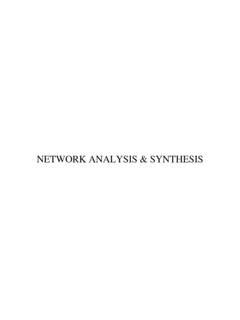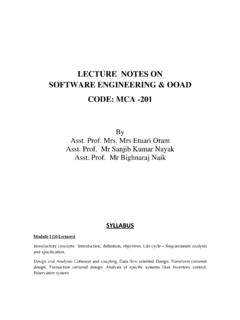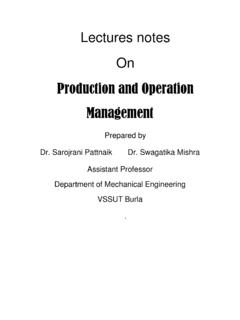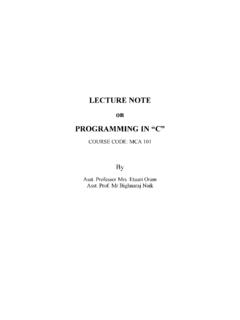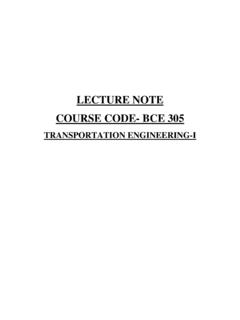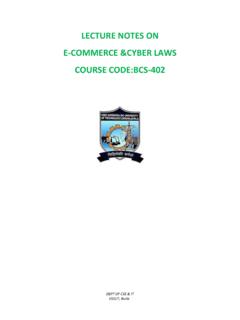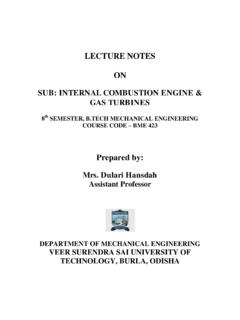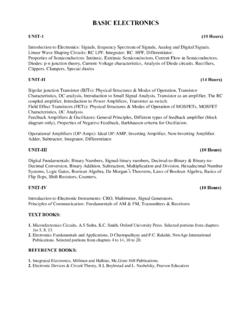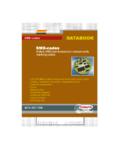Transcription of BASIC ELECTRONICS - VSSUT
1 BASIC ELECTRONICS . UNIT-1 (10 Hours). Introduction to ELECTRONICS : Signals, frequency Spectrum of Signals, Analog and Digital Signals, Linear Wave Shaping Circuits: RC LPF, Integrator, RC HPF, Differentiator. Properties of Semiconductors: Intrinsic, Extrinsic Semiconductors, Current Flow in Semiconductors, Diodes: p-n junction theory, Current-Voltage characteristics, Analysis of Diode circuits, Rectifiers, Clippers, Clampers, Special diodes UNIT-II (14 Hours). Bipolar junction Transistor (BJTs): Physical Structures & Modes of Operation, Transistor Characteristics, DC analysis, Introduction to Small Signal Analysis, Transistor as an amplifier, The RC.
2 Coupled amplifier, Introduction to Power Amplifiers, Transistor as switch. Field Effect Transistors (FETs): Physical Structures & Modes of Operation of MOSFETs, MOSFET. Characteristics, DC Analysis. Feedback Amplifiers & Oscillators: General Principles, Different types of feedback amplifier (block diagram only), Properties of Negative Feedback, Barkhausen criteria for Oscillation. Operational Amplifiers (OP-Amps): Ideal OP-AMP, Inverting Amplifier, Non-Inverting Amplifier. Adder, Subtractor, Integrator, Differentiator. UNIT-III (10 Hours). Digital Fundamentals: Binary Numbers, Signed-binary numbers, Decimal-to-Binary & Binary-to- Decimal Conversion, Binary Addition, Subtraction, Multiplication and Division, Hexadecimal Number Systems, Logic Gates, Boolean Algebra, De Morgan's Theorems, Laws of Boolean Algebra, basics of Flip flops, Shift Resistors, Counters.
3 UNIT-IV (10 Hours). Introduction to electronic Instruments: CRO, Multimeter, Signal Generators. Principles of Communication: Fundamentals of AM & FM, Transmitters & Receivers TEXT BOOKS: 1. Microelectronics Circuits, Sedra, Smith, Oxford University Press. Selected portions from chapters 1to 5, 8, 13. 2. ELECTRONICS Fundamentals and Applications, D Chattopadhyay and Rakshit, NewAge International Publications. Selected portions from chapters 4 to 14, 16 to 20. REFERENCE BOOKS: 1. Integrated ELECTRONICS , Millman and Halkias, Hill Publications. 2. electronic Devices & Circuit Theory, Boylestad and L. Nashelsky, Pearson Education MODULE-I.
4 INTRODUCTION TO ELECTRONICS : ELECTRONICS is the branch of science and engineering dealing with the theoty and use of a class of devices in which electrons are transported through a vacuum, gas or semiconductor. Signals: It contains information about a variety of things and activities. Example - Voice of the radio announcer, weather information Analog Signal: The signal magnitude can be represented at any instant of time by a sequence of numbers. Discrete Signal: It is a sequence of numbers that represent the magnitudes of the successive signal samples. Digital Signal: Signal is in the form of 0 and 1. Frequency Spectrum of Signal: Any arbitrary signal is characterized by its frequency spectrum.
5 The signal is represented in frequency domain. Fourier series: It is an expansion of periodic signal as a linear combination of sine and cosine with different frequencies and amplitudes. It is applied to periodic signals. Fourier transform: Fourier transform can be applied to aperiodic signals to find the frequency spectrum. Low Pass Filter: Filter that passes low frequency components of a signal but rejects the high frequency components of a signal is called as low pass filter. Filters designed with passive components (Resistor, capacitor, inductor) are called as passive filters. Behaviour of capacitor to frequency can be described as follows V 1.
6 For f=0 (Low frequency) capacitive reactance of capacitor Xc= = = , So it I 2pfC. acts as a open circuit V 1. For f= (High Frequency) capacitive reactance of capacitor Xc= = =0So it I 2pfC. acts as a short circuit Operation For low frequency since capacitor is open circuited, current flowing in the circuit is zero. So the output voltage vout= vin For high frequency since capacitor is short circuited, the output voltage across a short is zero So the output voltage vout= 0. The frequency response curve can be shown as below Calculation of cutoff frequency: vout= XC v in R + XC. vout = XC vin R 2 + XC 2. If R=Xc Vout= 1 vin= vin 2.
7 At the frequency of which R=Xc, the output will be of the input. 1. Xc=R=. 2pfC. 1. Cutoff frequency fc=. 2pRC. LPF as Integrator: Output voltage (current) is directly proportional to the integration of the input voltage(current). The time constant RC of the circuit should be very large as compared to the time period of the input wave. The value of R should be 10 or more times larger than Xc. For high frequencies the capacitor has insufficient to charge up, its voltage is small. So the voltage across the resistor is approximately equal to the input voltage. vin=VR. VR vin i= =. R R. The charge q on the capacitor at any instant is q= idt q idt 1.
8 Output voltage vout= vc=. C. =. C. =. RC. vindt High Pass Filter: Filter that blocks low frequency components of a signal but passes the high frequency components of a signal is called as high pass filter. Filters designed with passive components (resistor, capacitor, inductor) are called as passive filters. Operation For low frequency Since capacitor is open circuited, current flowing in the circuit is zero. So the output voltage vout= VR=0. For high frequency since capacitor is short circuited, So the output voltage vout= VR= vin The frequency response curve can be shown as below Calculation of cutoff frequency: vout= R v in R + XC.
9 Vout = XC vin R 2 + XC 2. If R=Xc Vout= 1 vin= vin 2. At the frequency of which R=Xc, the output will be of the input. 1. Xc=R=. 2pfC. 1. Cutoff frequency fc=. 2pRC. HPF as Differentiator: Output voltage (current) is directly proportional to the differentiation of the input voltage(current). The time constant RC of the circuit should be very small as compared to the time period of the input wave. The value of R should be 10 or more times smaller than Xc. For high frequencies the capacitor has enough time to charge up. So the voltage across the capacitor is approximately equal to the input voltage. vin= vc The charge q on the capacitor at any instant is q=C vc dq dvC dvi output voltage vout= iR= R=CR = CR.
10 Dt dt dt Semiconductor: Conductivity lies between conductor and insulator. Forbidden energy gap At 0K a pure semiconductor behaves as an insulator. Semiconductor materials show a reduction in resistance with increase in temperature. So said to have a negative temperature coefficient. Intrinsic Semiconductor: Semiconductor refined to reduce the number of impurities to a very low level. : Semiconductor in pure form Group-IV elements. Si, Ge, Extrinsic Semiconductor: To increase the conductivity, impurities also called dopant (Group III or V) are added to the pure semiconductor material and is called extrinsic Semiconductor (n-type or p-type).
